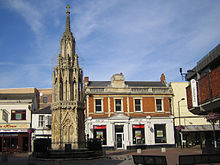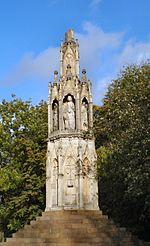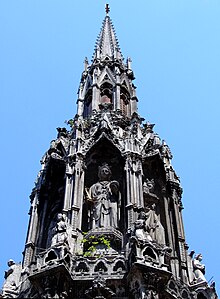Eleanor cross

Lua error in Module:Location_map/multi at line 27: Unable to find the specified location map definition: "Module:Location map/data/England south of the Humber and east of the Isle of Wight" does not exist. The Eleanor crosses were a series of twelve originally wooden,[citation needed] but later lavishly decorated stone, monuments of which three survive intact in a line down part of the east of England. King Edward I had the crosses erected between 1291 and 1294 in memory of his wife Eleanor of Castile, marking the nightly resting-places along the route taken when her body was transported to London. Several artists worked on the crosses, as the "Expense Rolls" of the Crown show, with some of the work being divided between the main figures, sent from London, and the framework, made locally. William of Ireland was apparently the leading sculptor of figures.[1]
Background
The procession

Upon her death in 1290 at Harby, near the city of Lincoln, the body of Queen Eleanor was carried to the Gilbertine priory of St. Catherine, Lincoln in the south of Lincoln, where she was embalmed. Her viscera were sent to the Angel Choir of Lincoln Cathedral for burial, where they still rest. Her body was then sent to London, taking 12 days to reach Westminster Abbey. The crosses were erected at the places where her funeral procession stopped overnight.
At Westminster she was buried at the feet of her father-in-law King Henry III. Her heart travelled with the body and was buried in the abbey church at Blackfriars.
Reasons for construction
A similar event had taken place in France for the body of King Louis IX in 1271, although his memorial crosses, unlike Eleanor's, were erected in part as a manifesto for canonisation; Edward had probably seen similar memorial crosses in France and elsewhere in Europe during his travels. They were at least in part intended as cenotaphs to provoke prayers for her soul from passers-by and pilgrims[2]
The twelve places
The only three crosses still standing are those at Geddington, Hardingstone, and Waltham Cross, although remnants of the lost ones can also be seen at other sites.




Lincoln
(53°12′51″N 00°32′47″W / 53.21417°N 0.54639°W)
The only remaining piece of the St Catherine's cross is in Lincoln Castle.
Grantham
(52°54′37″N 00°38′25″W / 52.91028°N 0.64028°W)
No part survives.
Stamford
(52°39′22″N 00°29′37″W / 52.65611°N 0.49361°W)
Only a small marble fragment survives, a carved rose excavated by the 18th-century antiquary William Stukeley;[3] it is currently preserved in Stamford Museum.[4]
See below for the modern monument erected by the Smith of Derby Group.
Geddington
(52°26′15″N 00°41′07″W / 52.43750°N 0.68528°W)
Still standing, it is the best-preserved of the three survivors. It is unique among the surviving crosses in having a triangular plan, and a taller and more slender profile with a lower tier entirely covered with diapering, instead of the arch-and-gable motif with tracery which appears on both the others; and canopied statues surmounted by a slender hexagonal pinnacle.[5]
Hardingstone, Northampton
(52°13′02″N 00°53′50″W / 52.21722°N 0.89722°W)
The Northampton cross is still standing at the edge of Delapré Abbey, on the side of the A508 leading out of Northampton, just north of the junction with the A45; the King stayed nearby at Northampton Castle. This cross was begun in 1291 by John of Battle. He worked with William of Ireland to carve the statues: William was paid £3 6s. 8d. per figure.
The cross is octagonal in shape and set upon some steps: the present ones are replacements. It is built in three tiers and originally had a crowning terminal, possibly a cross. It is not known when this became lost.[6] A local anecdote says that it was knocked off by a low-flying aircraft from a nearby airfield in the Second World War. This tale aside, there is mention of a "headless cross" at the site from where Thomas Bourchier, the Archbishop of Canterbury watched Margaret of Anjou's flight following the Battle of Northampton.[7]
The Cross is referred to in Daniel Defoe's Tour thro' the Whole Island of Great Britain, in his report on the Great Fire of Northampton in 1675, "...a townsman being at Queen's Cross upon a hill on the south side of the town, about two miles (3.2 km) off, saw the fire at one end of the town then newly begun, and that before he could get to the town it was burning at the remotest end, opposite where he first saw it."
Its bottom tier features open books. These probably included painted inscriptions of Eleanor's biography and of prayers for her soul to be said by viewers, now lost.
Stony Stratford
(plaque at 52°03′32″N 00°51′24″W / 52.05889°N 0.85667°W)
This cross stood at the lower end of the town, towards the river Ouse, on Watling Street (now the High Street), although its exact location is hotly debated. It is said to have been of a tall elegant design (perhaps similar to that at Geddington); it was destroyed during the Civil War by the Parliamentarians. The base survived for some time, but any trace has vanished. This commemorative plaque on the wall of 157 High Street is all that is now visible:
- Near this spot stood the Cross erected by King Edward the I to mark the place in Stony Stratford where the body of Queen Eleanor rested on its way from Harby in Nottinghamshire to Westminster Abbey in 1290[8]
Woburn
(approximately at 51°59′20″N 00°37′10″W / 51.98889°N 0.61944°W)
Work on the cross started in 1292, later than most of the others. A great part of the work was done by one Ralph de Chichester. No part survives. The precise location is unknown.
Dunstable
(51°53′10″N 00°31′16″W / 51.88611°N 0.52111°W)
Eleanor's coffin was guarded by Canons in the Dunstable Priory whilst local people mourned at the crossroads, the location where the original cross was then constructed. A shopping precinct in High Street North now contains a modern cross statue in her honour.[9]
St Albans
(51°45′04″N 00°20′26″W / 51.75111°N 0.34056°W)
A cross was erected in the Market Place at a cost of £100. It stood for many years in front of the fifteenth century Clock Tower in the High Street (opposite the Waxhouse Gateway entrance to the Abbey), and was demolished in the early eighteenth century due to neglect, and replaced by the town pump. A fountain was erected in its stead in 1874, which was subsequently relocated to Victoria Place.
Waltham (now Waltham Cross)
(51°41′09″N 00°01′59″W / 51.68583°N 0.03306°W)
The monument was constructed in co-operation between an architect and a sculptor: Roger of Crundale, who was the senior royal mason, and Master Alexander of Abingdon, respectively.[10] It is still standing, although it has been restored on several occasions, and the original statues of Eleanor were replaced by replicas during the last major restoration in the 1950s.[11] The original statues were kept for some years at Cheshunt Public Library; but they were removed, possibly in the 1980s, to the Victoria & Albert Museum. A photograph on the Lowewood Museum website[12] shows one of the original statues in front of a staircase at the library.
Westcheap (now Cheapside)
(51°30′51″N 00°05′41″W / 51.51417°N 0.09472°W)
Fragments are held by the Museum of London, and surviving drawings enable an accurate reconstruction to be established.
The Cheapside Cross was demolished in May 1643 under an ordinance from the parliamentary Committee for the Demolition of Monuments of Superstition and Idolatry, led by Sir Robert Harley. The cross was the third incarnation of the monument, which had been reconstructed and refurbished several times in the preceding three centuries, in which time it had enjoyed the protection of various monarchs and the Mayor and Corporation of London.

Matters came to a head during the years running up to the English Civil War, when the cross was seen to encompass the doctrinal debates of the period. To puritanical reformers, it was identified with 'Dagon', the ancient god of the Philistines and was seen as the embodiment of Royal Catholic tradition. At least one riot was fought in its shadow as opponents of the cross descended upon it to pull it down and supporters rallied to stop them.
After Charles I had fled London to raise an army at the start of the Civil War, the destruction of the cross was almost the first order of business for Harley's commission. Though less well known than the Charing Cross, the downfall of the Cheapside Cross is one of the most interesting and arguably important examples of iconoclasm in English history.
Fragments of this cross are displayed in the Museum of London.[13]
Charing (now Charing Cross)
(51°30′26″N 00°07′39″W / 51.50722°N 0.12750°W)

The cross at Charing Cross, in what was then the Royal Mews, was the most expensive, built of marble in co-operation between an architect, Richard of Crundale, who was the senior royal mason, and a sculptor, Master Alexander of Abingdon.
According to romantic folk etymology, Charing derives from French chère reine (dear queen),[14] but the name was certainly used in the contemporary royal accounting records for the costs of constructing the cross. The name Charing probably comes from the Anglo-Saxon word cerring, a bend, as it stands on the outside of a 90-degree bend in the River Thames (see Charing in Kent). The original cross stood at the top of Whitehall on the south side of Trafalgar Square, but was destroyed on the orders of Parliament in 1647 during the Civil War, and was replaced by an equestrian statue of Charles I in 1675 following the Restoration. This point in Trafalgar Square is regarded as the official centre of London in legislation and when measuring distances from London.[15]
A replacement cross was erected in 1865 in front of Charing Cross railway station, a few hundred yards to the east along the Strand. It is not a faithful replica, being more ornate than the original. It stands 70 ft (21 m) high and was commissioned by the South Eastern Railway Company for their newly opened Charing Cross Hotel. The new cross was designed by the architect of the hotel, E.M.Barry, who is best known for his work on Covent Garden. It was constructed by Thomas Earp of Lambeth from Portland stone, Mansfield stone (a fine sandstone) and Aberdeen granite.[16] It was restored to a substantial extent between October 2009 and July 2010.[17]
Replicas and imitations
-
The modern sculpture in Stamford inspired by the original cross
-
detail of the carving on the new monument
During the nineteenth and early twentieth centuries several replica Eleanor Crosses were erected, including at Ilam in Staffordshire, Walkden in Lancashire,and at Sledmere in the East Riding of Yorkshire.The Queen Victoria Monument, Birkenhead Wirral, Merseyside, unveiled in 1905. is in the form of an Eleanor cross. The Ilam cross was built in 1840 by Jesse Watts Russell of Ilam Hall to commemorate his wife.[18] The Market Cross in Glastonbury resembles an Eleanor cross.
The start of the 21st century was marked in Stamford by erecting a modern monument inspired by the lost Cross. It stands in Sheepmarket, rather than at the original location. The carved detail is based on the fragment in Stamford Museum.
References
- ^ Charles Henry Hartshorne, On Queen Eleanor's Cross at Northampton, Journal of the British Archaeological Association, March 1863, p. 224
- ^ Chronicle of St Albans
- ^ Stamford Mercury "Overwhelming evidence on site of Eleanor cross"
- ^ Stamford Museum
- ^ English Heritage: Geddington's Cross
- ^ The Buildings of England – Northamptonshire. N Pevsner (Second edition). ISBN 0-300-09632-1
- ^ Adkins, W.R.D., ed. The Victoria History of the County of Northampton. -vol iii, p3 (1906)
- ^ Stony Stratford's Eleanor Cross
- ^ Dunstable cross on the Bedfordshire website.]
- ^ Image of the cross at Waltham.
- ^ [1][dead link]
- ^ [2][dead link]
- ^ Alexander, Binski (1987). Age of Chivalry. Royal Academy of Arts. p. 364.
- ^ "The Eleanor Crosses". Eleanor of Castille. Museum of London. Retrieved 12 November 2013.
- ^ Where Is The Centre Of London? BBC
- ^ "Charing Cross". Network Rail. Retrieved 22 January 2011.
- ^ "Renovated Eleanor's Cross in Charing Cross unveiled". News London. BBC. 9 August 2010. Retrieved 10 August 2010.
- ^ Ilam photograph
External links
- A link to a short article with images describing the likely circumstances surrounding the transfer of Queen Eleanor's body to Westminster
- Art & Architecture article on the Eleanor Crosses
- Adrian Fletcher's Paradoxplace – Eleanor Cross Page
- Web page and link to pdf about the Stamford cross
- Coles, Ken (February 1980). "Queen Eleanor's Cross". The Stamford Historian. Stamford research group. Retrieved 3 April 2013.
{{cite journal}}: CS1 maint: postscript (link)


